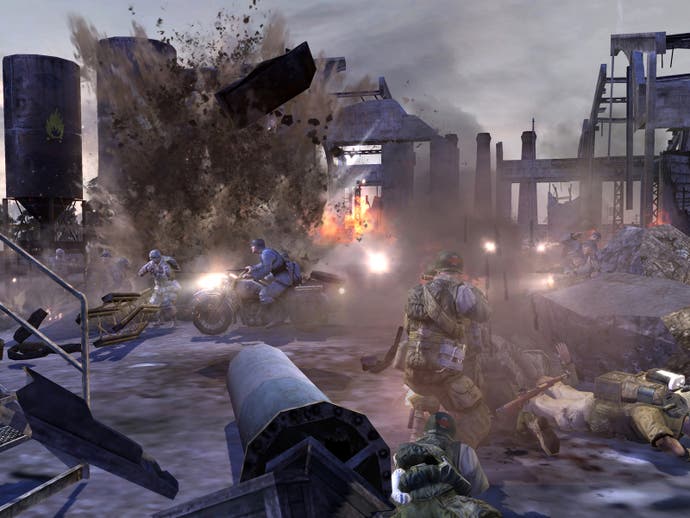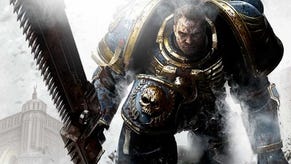Company of Heroes
In the Company of Ico, Deus Ex...
Similarly, the grenade throwing mentioned earlier. Grenades are an upgrade you can equip your soldiers with, allowing them to expend resources to lob a grenade. Deciding where and when it's right to reach for the explosives is an important tactical decision and... well, naturalistic, detailed and tactically compelling. Or, to expand to other units than machine-guns and foot-soldiers, vehicles take damage depending on which angle you strike them at. Tanks especially - and doubly so if struck from a distance - can take little damage from a frontal attack, even having shells ricochet away. If you can get behind them, or catch them in a cross-fire, or set up impassable barricades which force incoming armour to have to turn at a critical moment to get hit by an anti-tank gun... well, you'll take them down far quicker. Or if you have a tank in a precarious position, the art of clicking just behind it to make it speedily reverse out of trouble rather than turn around and expose its vulnerable hindquarters is enormously satisfying. Or, in short, Company of Heroes offers the gamer a lot of micro-management, if you want to. But it's fun micromanagement, whose results you can immediately appreciate.
Before we get into more dramatic areas again, a quick take on the game's resource systems. A word on expending resources: the game's economy is based on the three resources of manpower, munitions and fuel, which you receive for having control of positions (ala Dawn of War), so forcing a player to expand and enter conflict if they want to gain in power. Manpower is mainly used for recruiting, with fuel as a secondary resource for recruiting vehicles. Munitions is used primarily for upgrades or one-off attacks, like grenades. Whether it'll be best to blow all your 125 remaining munitions on a one-off calliope rocket-strike or a handful of precision grenades or anti-tank pipe-bombs is the sort of thing you'll find yourself obsessing over in your passing moments.
And another state-the-obvious time: It's beautiful, though that's entirely the wrong word. This is a war game, so the word should be "visceral" or something. Models are hugely detailed for an RTS, physics implemented impressively and so on. But relevantly, it's a functional sort of beauty (or - er - viscerality). The core facet of its appeal is how destructible each level is. Everything from hedgerows to buildings can be reduced to... well, not hedgerows or buildings. Rocket strikes turn the ground into craters - which then can be used as cover. It's clear which places have been closely fought over. Most likely, they won't be there anymore.
The buildings are particularly brilliantly executed, with foot soldiers being able to be ordered inside where they set up at the windows, dealing with anyone who comes near (it's a particularly brutal way to use your machine-guns, as they're able to change the direction they fire far quicker). In a built up area, they become hard-points of defense, slowly getting knocked down, the troops inside visibly getting more exposed. Take down the building with explosives or thrown satchel charges or the inhabitants with a carefully applied sniper, then move in.

Away from the buildings that are already there, your ability to build is as balanced as the rest of the game is towards giving you the most entertaining decisions at any time. Constructing your base itself is relatively basic. Conversely, the actual construction of defenses is hugely important. Engineers (or foot-soldiers, if you take a certain upgrade path) can lay down sandbags, barbed wire and anti-tank barricades to create cover, prevent the movement of infantry and prevent the movement of tanks respectively. Except, rather than most games which charge you resources for this, Company of Heroes just lets you create as much as you have time to do. This encourages much creative thinking. For example, a machine-gun can be made even less vulnerable to frontal assault by a line of sandbags. Yet again, it's the sort of interaction that's perfectly natural and completely satisfying. And returning to the campaign, the genre staple missions - like the "Defend this area for a time limit" ones - are improved hugely just by how these mechanics work. When you have all these options with these robust tools, analyzing chokepoints, creating your own and so on... it's just about as good as a strategy game gets. Which is Company of Heroes all over.
Of course, there are things I wish were different.
I wish its method for getting troops out of buildings was a little more robust.
I wish that some of its unit's types being designed as conscious counters for others were less glaring. It's mainly noticeable with the anti-armour guns, despite just being a few guys huddled behind a cannon, being a little too obviously resilient towards tanks... which hurts atmosphere a little. Momentarily.
I wish that it had an AI level beneath its "easy" for when you just want to experiment with the tech.
I wish, despite my shrugging earlier in the review, they had managed to get a third army in.
Lots of little wishes.
But mostly, I wish that we saw games this good more often.
Bored of World-war 2 games? Bored of the mainstream real-time strategy game? Just plain bored?
After Company of Heroes, you won't be.















